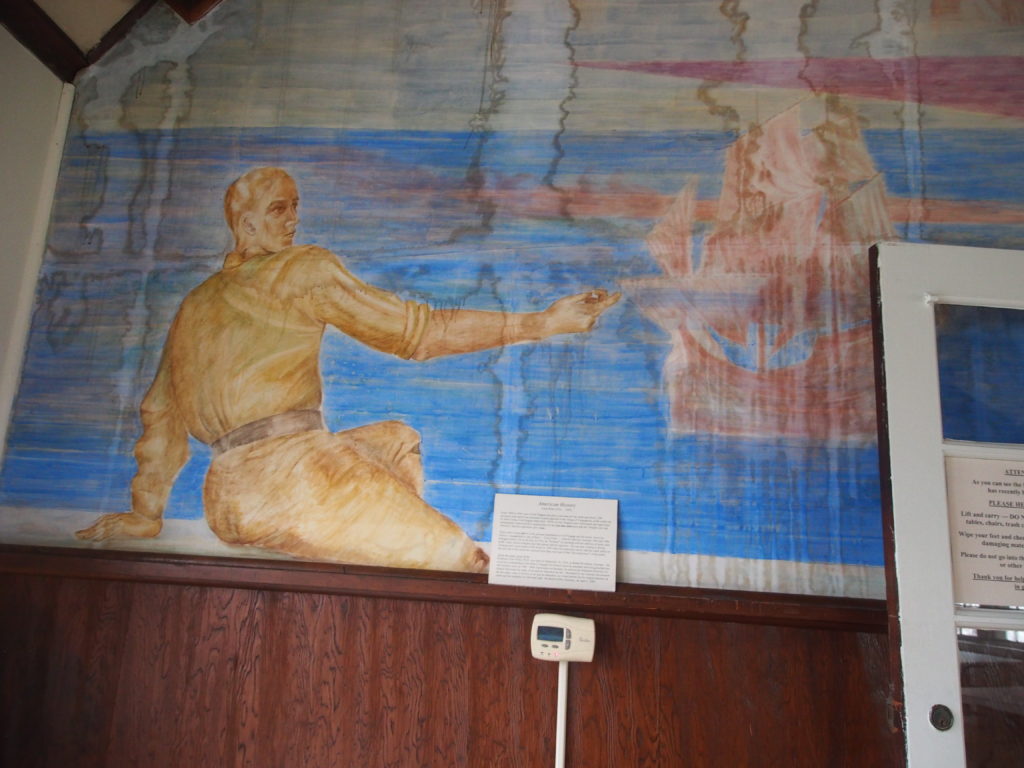art at fort niagara

Ernst Wille (1916-2005) was a German artist and teacher who was drafted into the army during World War II. Apparently, he was a better artist than soldier. During the Normandy invasion, Ernst Wille was one of a large number of German soldiers captured by the Allies. Many of those captured soldiers were held in prison of war camps in Great Britain and in the United States. All of those camps were full so a new one was opened at Fort Niagara, which also served as an induction center for many American troops during World War II.
Ernst Wille had, before the war, studied art at the art school in Cologne, Germany. When he was transported to the prisoner of war camp at Fort Niagara, his art skills went with him. He was given the opportunity to paint a mural in the bachelor officers quarters and that started his relationship with the United States that lasted for the rest of his life.

Ernst Wille didn’t like war and, apparently, he didn’t want to glorify it with a mural. So he chose the theme “American history” for his mural. He spent two years painting and was then sent back to Germany, as the war had ended. When he was repatriated to Germany, the mural was still incomplete. In 1948, the state took over the land that Fort Niagara is on and it became a state park. Ernst Wille returned to the park several times to work on the painting, which he completed in 1999. At one point, there was a leak in the roof, and the painting suffered water damage. He was asked if he wanted to fix the painting to eliminate the effect of the water damage. He declined, saying that the water damage was part of the history of the painting.
Back in Germany, Ernst Wille entered the art school in Munich. He later became a teacher and received many honors for his contribution to education and art in Germany. As an artist, he found an original style that showed his vision of color and form. His style was abstract sometimes and more representational other times, and always vivid, full of life and joy.
This is a fascinating story about Ernst Wille and his connection to the United States through his mural at Fort Niagara. It’s interesting to see how his experiences as a prisoner of war shaped his art and his relationship with the country. The fact that he chose to depict American history in the mural, rather than glorifying war, shows his unique perspective and desire to understand and appreciate the culture. It’s also noteworthy that he returned to the mural several times over the years, including to address water damage, to ensure its preservation and completion. His dedication to the mural is a testament to his artistic passion. I also appreciate that he recognized the water damage as part of the painting’s history and chose not to remove it. Overall, it’s a great reminder of the power of art to connect people and cultures, even in the midst of conflict.
Thank you for your insights, Paul, and for reminding me of the power of art to cross cultural and language barriers. Ernst Wille did both extremely well as, I heard from the guide leading the tour, he never learned to speak English. His art spoke for him and it told many stories.
Alice, thanks for the fascinating story. I second all that Paul said. And Mr. Wille came back in 1999!! He certainly loved that piece! And maybe he hoped it would encourage people to reach beyond war, as the soldier appears to be reaching.
Thank you, Kebba. I think that’s what Mr. Wille was doing through his painting… reaching beyond war. And I also think that people become attached to places. He had a good experience in Fort Niagara, despite being a prisoner of war. He left a piece of himself behind, in the form of the mural. So he became part of the land here and he might have felt a need to come back and tend to it. His artistic style had, for sure, changed so what he did in 199 was an act of love.
What a wonderful day this was and I’m so glad you went with us on the tour! I felt like I just got to do it again after reading your vivid description. One additional point of interest that I recall our tour guide telling us was ear Willie painted the beach of Normandy on June 4 just before the D Day invasion. It was a peaceful beach so Barb wire being the only sign of war. He sent the painting home to his family before D Day so it survived the war. The family later donated it to Fort Niagara and it’s displayed in the visitors center.
I look forward to our next awesome adventure together Alice!
Thank you, Cherrish, for inviting me. It was such a good experience, and I am very grateful to you for including me in this adventure. I’m so happy that you remembered about that painting that Ernst Wille did on the beach. I wish that I could have met him. Art was his entire life, and I could have learned so much from him.
And I am so excited to go on more adventures with you.
Considering his views on war, becoming a prisoner would have provided a better way to escape the war and do what he loved apart from all the turmoil that was going on at home.
Yes, that’s true. And, as a pacifist myself, I understand completely his gratitude at having been able to escape the war. Doing what he loved was, for sure, a bonus.